Introduction
Managing multiple campaigns, balancing individual workloads, measuring asset effectiveness, and, above all, managing marketing resources – both flexibly and regularly – is a whole lot of tasks.
While these tasks may seem doable, the scattered nature of this process can easily feel overwhelming. Being in the marketing manager’s position, I’ve experienced the challenge myself.
The solution?
Marketing Resource Management (MRM) – an approach and software to centralize all marketing projects and assets – from approvals, reporting, and metric tracking.
Let me walk you through the benefits, strategies, and challenges of marketing resource management. And that’s just not it.
By the time you finish reading about MRM, you will also get to know MRM software to centralize all your distinct marketing identities into one ecosystem.
But let’s first understand marketing resource management in detail.
What is marketing resource management (MRM)?
Marketing resource management (MRM) is a holistic approach to managing a marketing team’s resources – budget, people, supplies, technology, and digital assets.
According to Gartner’s current MRM definition, “Marketing resource management applications enable strategic planning and budgeting, program management, creative development and distribution, content management, media planning and execution, event coordination, and resource measurement.”
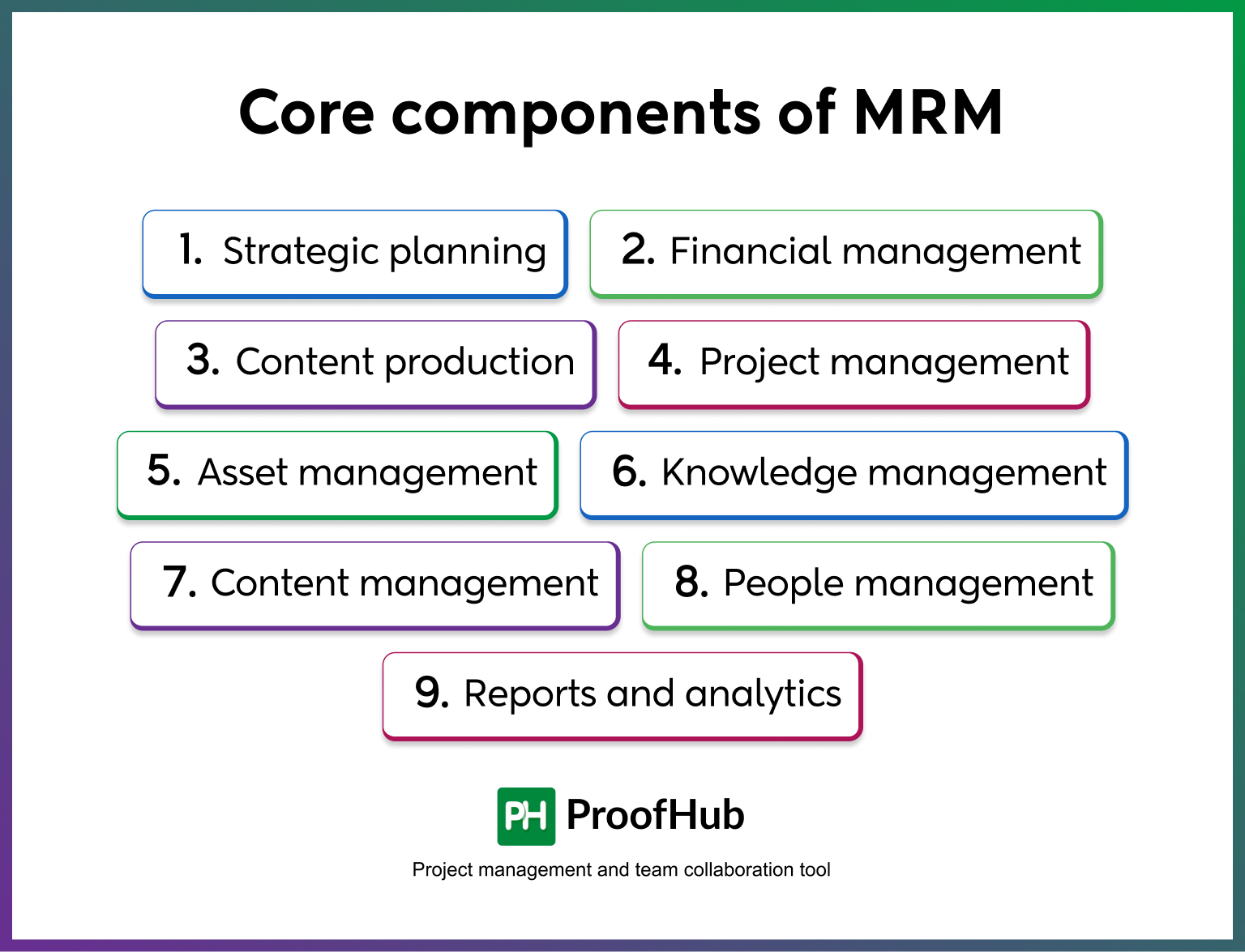
The core components of MRM that contribute to the marketing department’s success include:
- Strategic planning: Define your overall marketing goals and objectives and how you aim to achieve them.
- Financial management: Allocate marketing funds effectively, track spending, and ensure campaign budgets do not exceed the limit.
- Content production: Streamline content creation workflows by managing digital assets and aligning content with marketing strategy.
- Project management: Plan, organize, and track marketing projects to ensure seamless marketing campaign execution.
- Asset management: Store, organize, and manage digital marketing assets in one centralized platform.
- Knowledge management: Collect, manage, and share marketing knowledge within the team.
- Content management: Create, plan, schedule, and publish content across various channels to maintain a consistent brand voice.
- People management: Foster team collaboration and optimize resource scheduling for leading marketing teams. It also involves handling external vendors and con
- Reports and analytics: Gain insights into reports and track metrics to measure campaign performance and effectiveness.
The process aims to optimize the utilization of resources for increased efficiency, cut down expenditures, and better campaign performance.
Also read – Utilize marketing reports to turn insights into action and drive success for your campaigns.
Benefits of marketing resource management
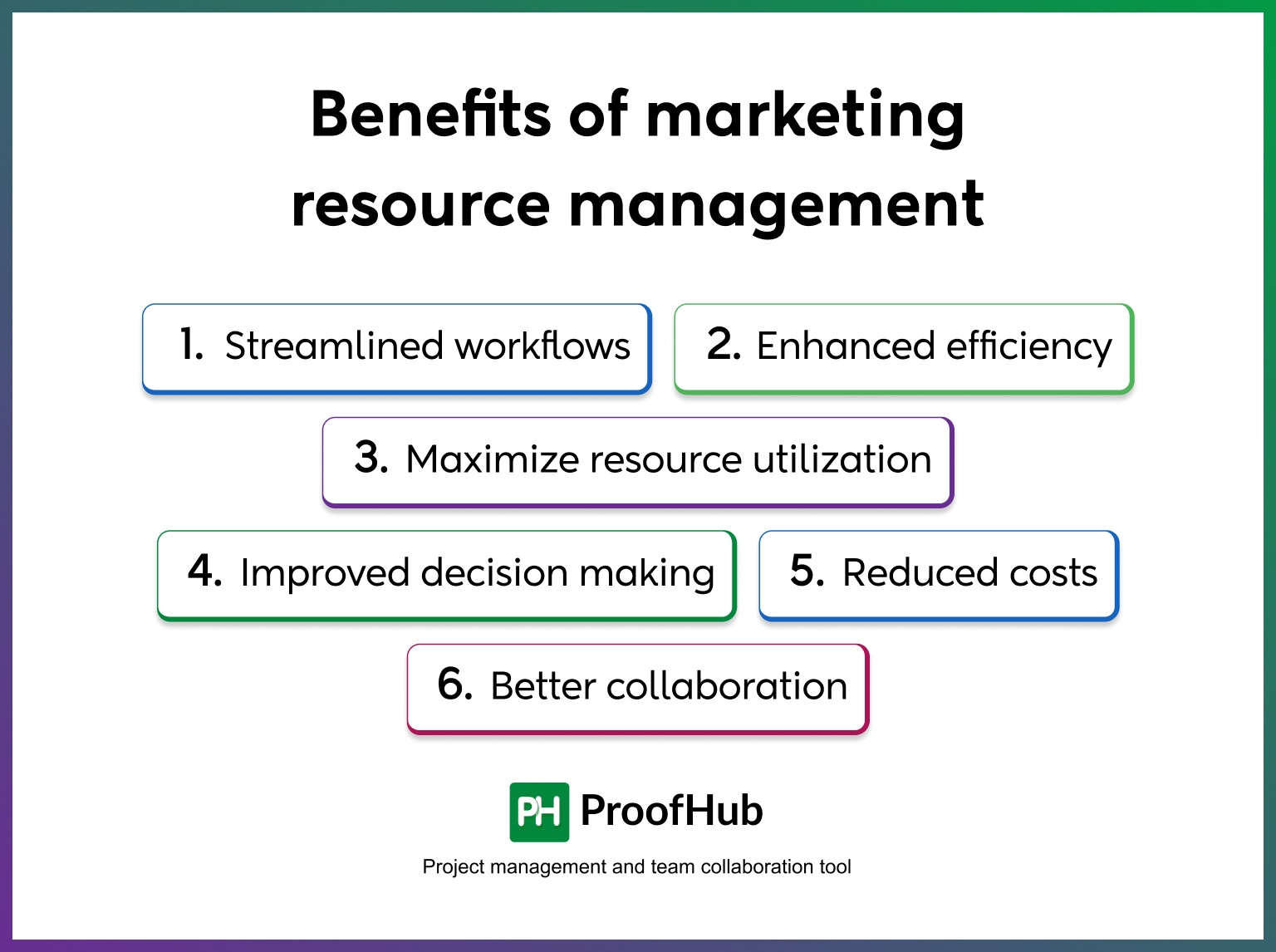
MRM offers multiple benefits to marketing departments. Some of these include:
1. Streamlined workflows
By defining clear milestones, assigning clear deadlines, and aligning resources, you can eliminate the scope of ambiguity and unexpected delays from your workflow and keep it running successfully.
2. Enhanced efficiency
MRM benefits marketing managers by allowing them to focus on strategic initiatives. It cuts down on duplication work, discrepancies, and manual efforts to streamline the marketing operation.
3. Maximize resource utilization
It enhances your visibility into your team’s workload, time invested, and budget overruns. You can get a bird’s eye view of these parameters to practice smart allocation and resource optimization.
4. Improved decision making
With MRM, you can get the right access and insights into resource utilization and availability to make smart, better, and informed decisions. You can even utilize the information to plan your future initiatives.
5. Reduced costs
71% of CMOs are facing budget restrictions while executing their strategy. MRM resolves these issues by saving them cost and time. It does so by managing marketing materials and avoiding redundancies.
6. Better collaboration
Marketing resource management enhances collaboration standards in your operations by creating a central repository. It brings all your resource information like digital assets, communication, and feedback into one platform.
Who can benefit from MRM?
Marketing resource management isn’t limited to a specific company size, project type, or industry. Any organization needing coordination and collaboration between departments, teams, or individuals, who can utilize MRM for steady growth and tangible benefits.
It is highly beneficial for teams with team members scattered across the globe, and requiring multiple external stakeholders and freelancers interactions.
Creative teams, marketing agencies, and service providers, all can use MRM to streamline processes and take on more marketing projects. Startups and growing businesses can especially benefit from the versatile architecture of MRM software to achieve marketing goals efficiently.
Marketing resource management strategies
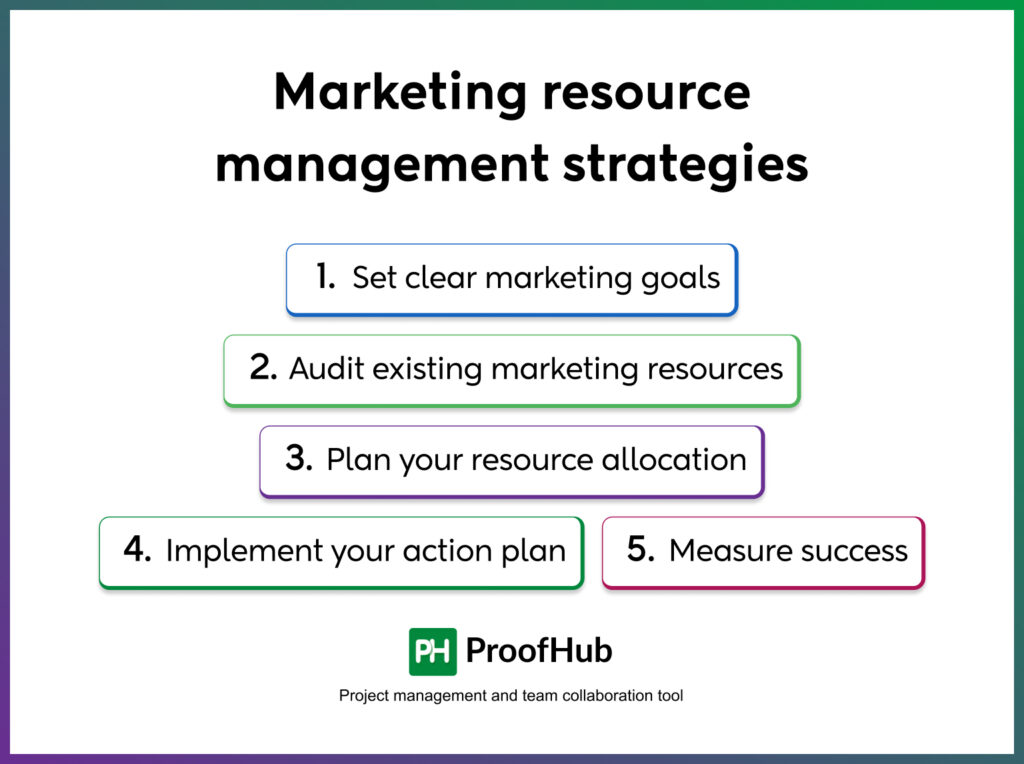
Think of the MRM strategy as a central command center for your marketing team. To develop an effective marketing resource management strategy for optimal resource allocation for your marketing initiatives, follow these steps –
1. Set clear marketing goals
The first step in creating a marketing resource management strategy is defining the objectives you aim to achieve. Make sure you set SMART goals – Specific, Measurable, Achievable, Relevant, and Time-bound for each marketing aspect.
By doing so, you can ensure optimal resource allocation in your strategy for enhanced campaign performance. You can even analyze previous campaign performances to gather data and insights for informed decision-making.
2. Audit existing marketing resources
Moving forward, conduct a thorough audit of your available marketing resources. For example, you can identify the skill gaps in your current team and the lacking functionalities in your tech stack. Also, do not forget to evaluate the current allocations and spending patterns. It is only after you uncover efficiencies that you can address and mitigate them accordingly.
3. Plan your resource allocation
Once you are done defining your marketing goals and conducting a resource audit, plan your resource allocation. Align your resource efforts to the right task after a thorough evaluation of priorities and the potential impact these may impose on your objectives. Be strategic in your actions. Ensure no resource goes underutilized.
Also read – Optimize your resource allocation strategies to maximize efficiency and drive project success
4. Implement your action plan
After the extensive planning stage, hop on to creating a roadmap for the implementation of your MRM strategy. Define your task list, establish timelines, and set milestones that mark the progress.
You can use project management software like ProofHub to create, assign, and manage tasks. Also, you can even clarify what is expected of them by providing descriptions. This ensures that everyone stays on track and accountable for their work.
5. Measure success
With the key performance indicators defined, you can measure the success of your MRM strategy. Your KPIs should be a clear reflection of your goals and objectives. Also, you must consistently monitor these parameters to stay aligned with new market trends and patterns. This ensures your MRM strategy’s effectiveness and efficiency for longer-term success.
Also read – Craft a winning marketing plan to captivate your audience and leave an everlasting impact
Best practices for effective MRM
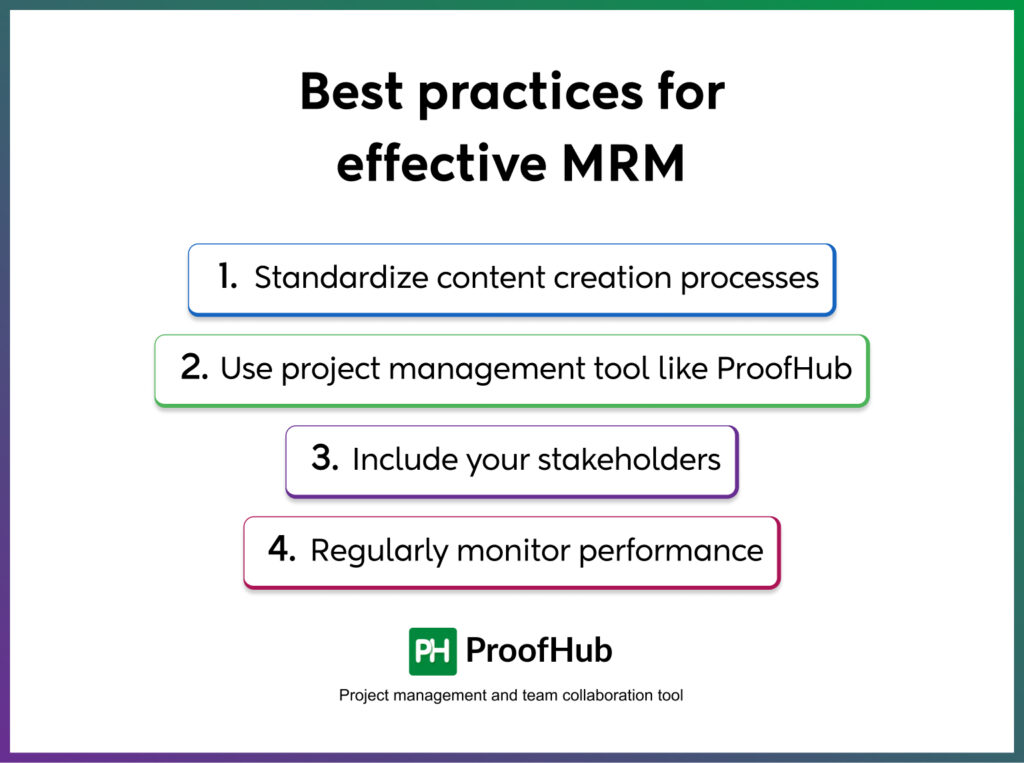
To ensure the successful implementation of your MRM initiatives, embrace these practices in your marketing workflow –
1. Standardize content creation processes
Centralize all your marketing assets distributed across different platforms in one consolidated space. Don’t forget that you may have to navigate back and forth to track previous changes made to the documents. That is why, having version control of your assets is crucial. It facilitates access to previous versions, whenever required and ensures everyone has access to the latest information.
2. Use project management tools
Utilizing project management tools like ProofHub brings structure and organization to your marketing workflows. With these tools in your arsenal, you can
- Easily assign marketing tasks to not just one but multiple team members.
- Set deadlines, include descriptions, and add relevant labels to tasks to set clear expectations.
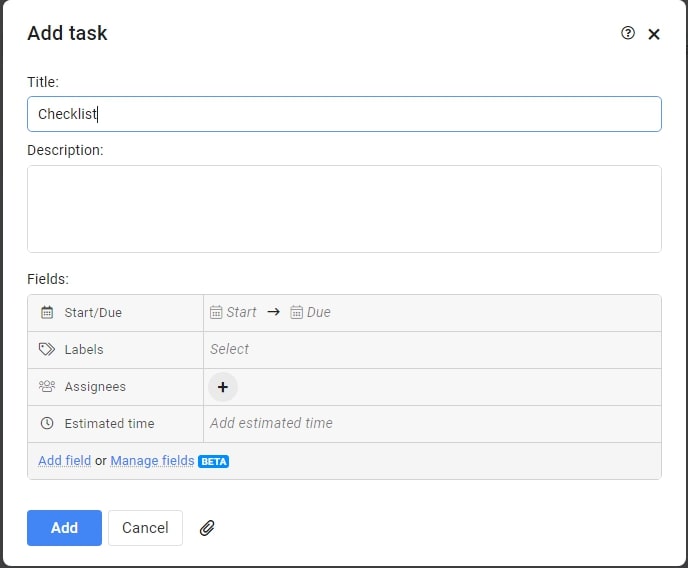
- Share and upload your marketing assets directly within the tasks to avoid looking around.
- Track task progress and performance in real-time using Kanban boards or Gantt charts.
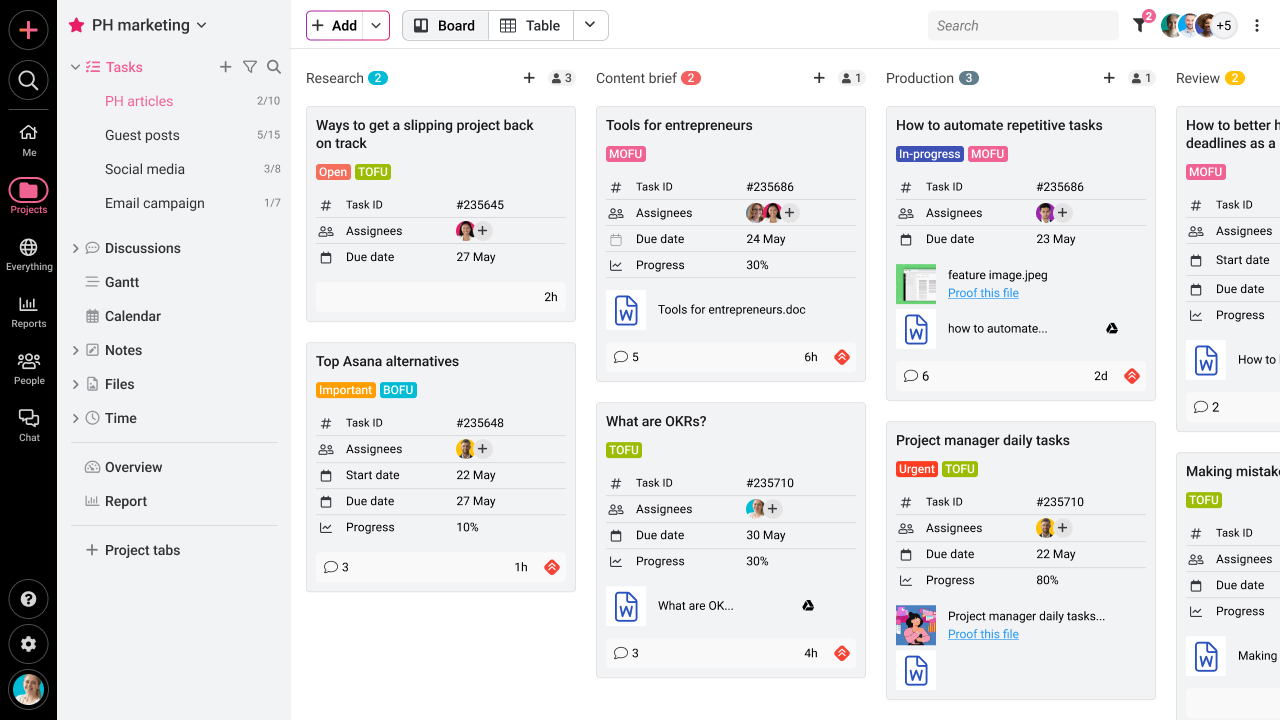
- Facilitate communication between team members through built-in chat, discussion boards, and task comments.
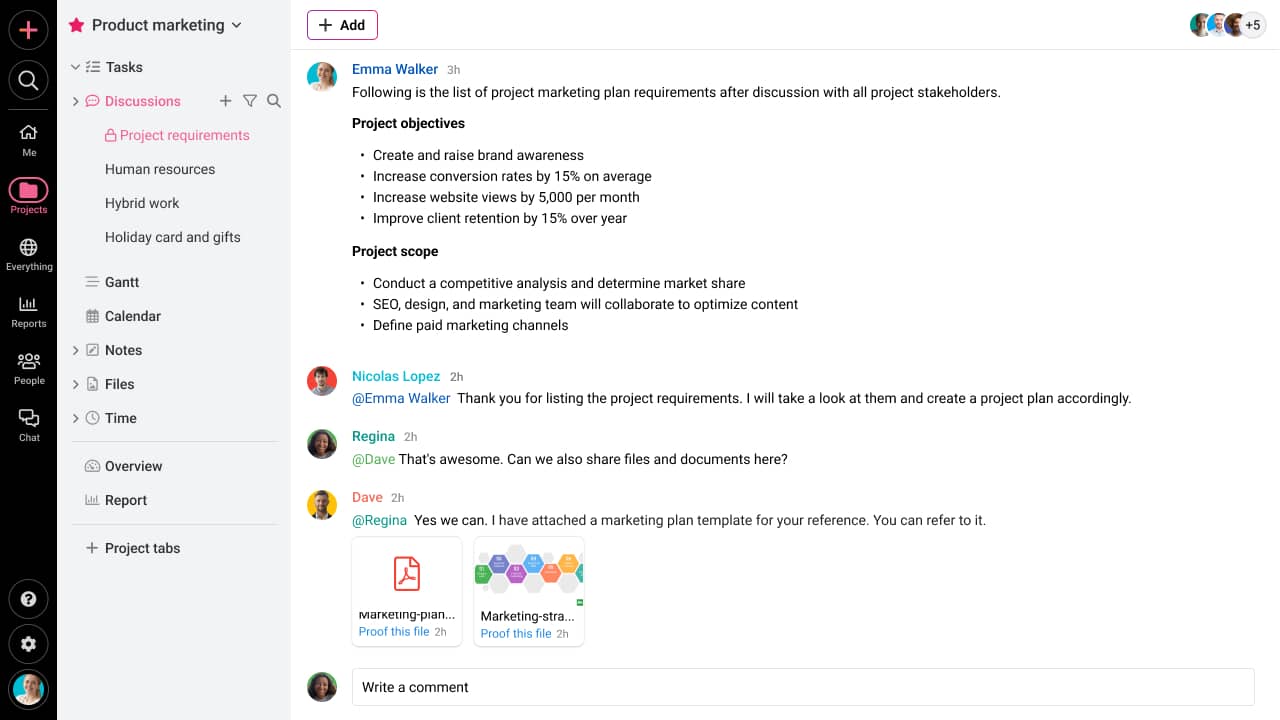
3. Include your stakeholders
Moving forward, bring in the unique perspective of all your stakeholders. Identify the aspects operating well while highlighting the areas requiring improvements for added value. Also, respecting their viewpoints and feedback will increase their acceptance of the change. This will help you gain consensus when implementing the MRM strategy.
4. Regularly monitor performance
Do not jump directly into the solution without identifying the problem and understanding its severity. Visualizing your current marketing operations helps you identify hidden gaps, pinpoint inefficiencies, and uncover data silos. You can utilize this information to adjust and address issues accordingly to draw continuous improvement.
Check out our comprehensive reports to gain valuable insights into your marketing initiatives
Marketing resource management challenges
Marketing managers may face several challenges when implementing marketing resource management solutions into their operations:
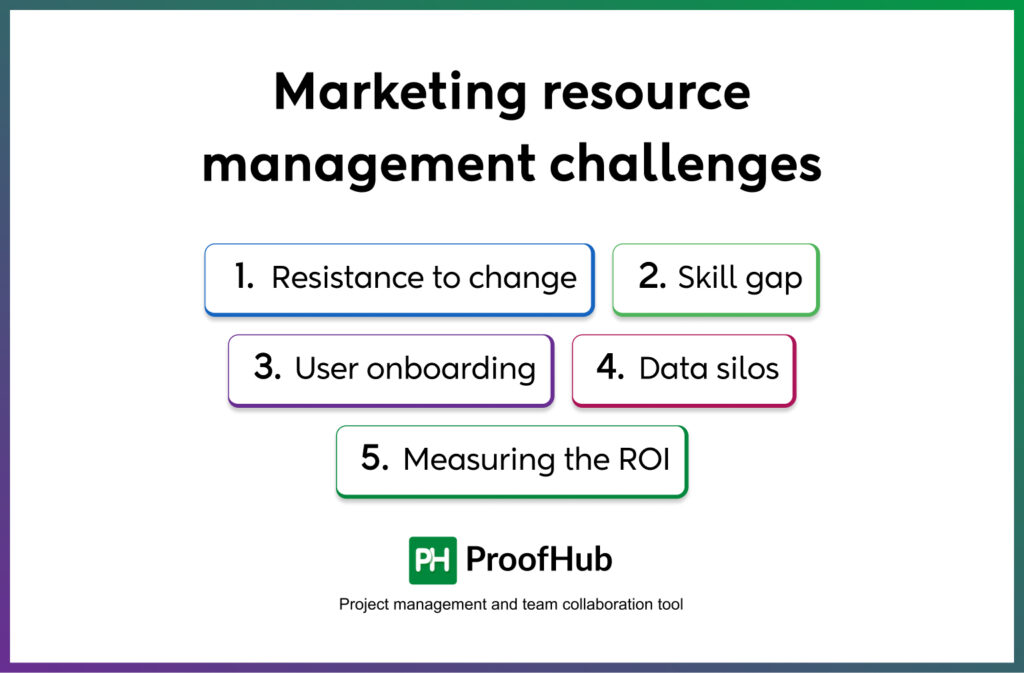
1. Resistance to change
The major challenge companies can face while implementing MRM is witnessing resistance from team members. You may struggle to change your employees’ perspective into being adaptable to the approach.
Pro tip: Try communicating MRM benefits and values to team members to maximize adoption rates. Allow them to express their concerns while demonstrating the effectiveness and improvements MRM software can bring in response.
2. Skill gap
Employees lack the necessary knowledge and expertise to run the MRM solution to its maximum potential. This leads to the underutilization of features for optimal benefits.
Pro tip: Host comprehensive training sessions to provide both initial and ongoing support to your employee base. This makes them feel confident and competent in their role.
3. User onboarding
New users feel overwhelmed with tool functionalities and can’t use the tool effectively. They feel skeptical about their abilities to navigate the system, resulting in reduced productivity and insufficient utilization.
Pro tip: Look for solutions that provide training resources to help users get familiar with their user interface. You can assign a mentor to provide essential guidance and support to facilitate learning and adoption.
4. Data silos
Your data might be stored in multiple isolated locations. Integrating them into one core MRM system might be challenging.
Pro tip: Look for an MRM solution that integrates with available tools in the organization. This helps you eliminate data silos and brings all your assets into one central location. Once implemented, you can even establish standardized data management practices and protocols to ensure consistency.
5. Measuring the ROI
Before MRM software implementation, speculating on return on investment can be a major hurdle that might impact successful implementation. This will come your way to communicating the solution’s value to the stakeholders.
Pro tip: If you define clear KPIs from the very beginning, you can define a benchmark to measure MRM performance. To stay informed about its effectiveness in the long run, conduct regular ROI assessments.
What is marketing resource management software?
Marketing resource management software is a set of applications that helps managers implement MRM strategy into their workflow. It declutters, organizes, standardizes, and optimizes your marketing operations to create, plan, and control your campaigns.
Gartner’s MRM 2.0 version, released in 2017, explains MRM technology, “The tools and technologies known as marketing resource management have evolved. Marketing leaders can use this research to understand and embrace the vendors and solutions that deliver improved marketing operational efficiency and business impact through MRM’s evolution.”
These marketing tools and software fall into three sections of marketing management:
- Work management: Creation, production, and management of marketing materials
- Asset management: Organization, storage, and sharing of digital assets
- Performance management: Strategic resource planning, tracking metrics, and reporting
All these components empower marketing resource managers to run their marketing campaigns and initiatives effortlessly and effectively.
Explore our comprehensive list of marketing tools to not let marketing inefficiencies hold you back!
Key features of MRM software
Some of the key features you should look for when selecting a marketing resource management platform are –
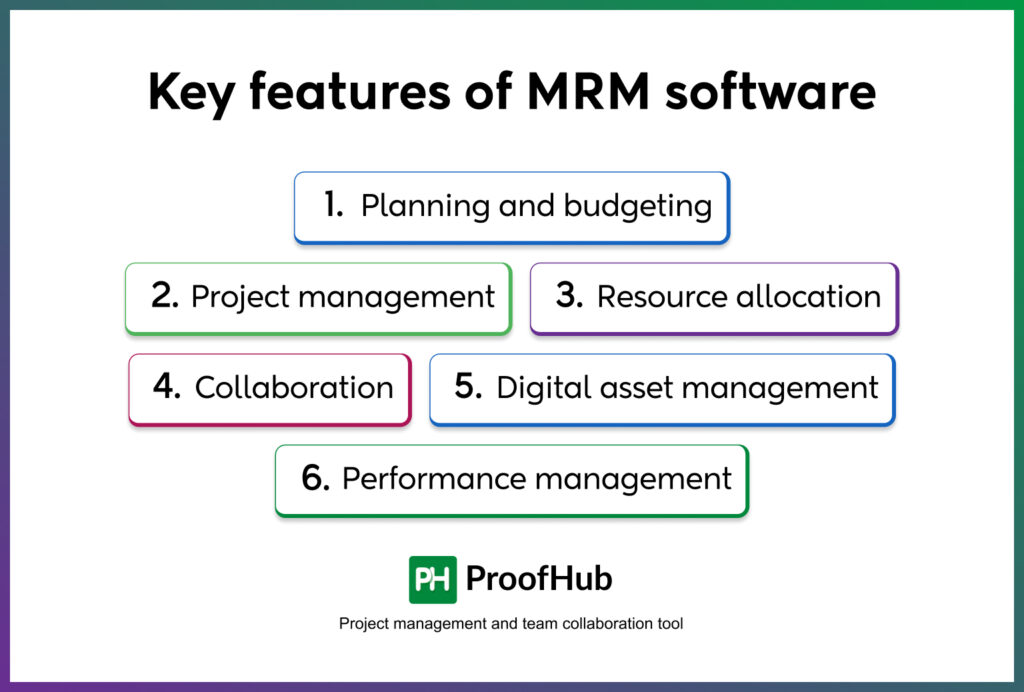
- Planning and budgeting: A good MRM allows you to set the stage. You can do that by defining marketing goals and planning projects. Tracking budgets is also crucial to respect financial boundaries.
- Project management: Features like task assignments, resource management, deadlines and milestones, Kanban boards, project views, time tracking, etc., are necessary to keep the work moving forward effortlessly.
- Resource allocation: Powerful and comprehensive reports help you get insights into resource workload and effectiveness. This ensures you allocate the right people to the right task.
- Collaboration: A good MRM provides a space to facilitate real-time collaboration using built-in chat, threaded discussion section, feedback column, file sharing, and real-time updates.
- Digital asset management: A central library of digital assets is necessary to streamline marketing processes. It should also allow stakeholders to review, view, approve, and give feedback on these assets.
- Performance management: Project performance reports, time utilization reports, and resource utilization reports are some tools with which you can determine the performance of your campaign backend.
How to choose the right MRM software?
There are a lot of factors you must consider when researching the purchase of an MRM platform. Some of these include:
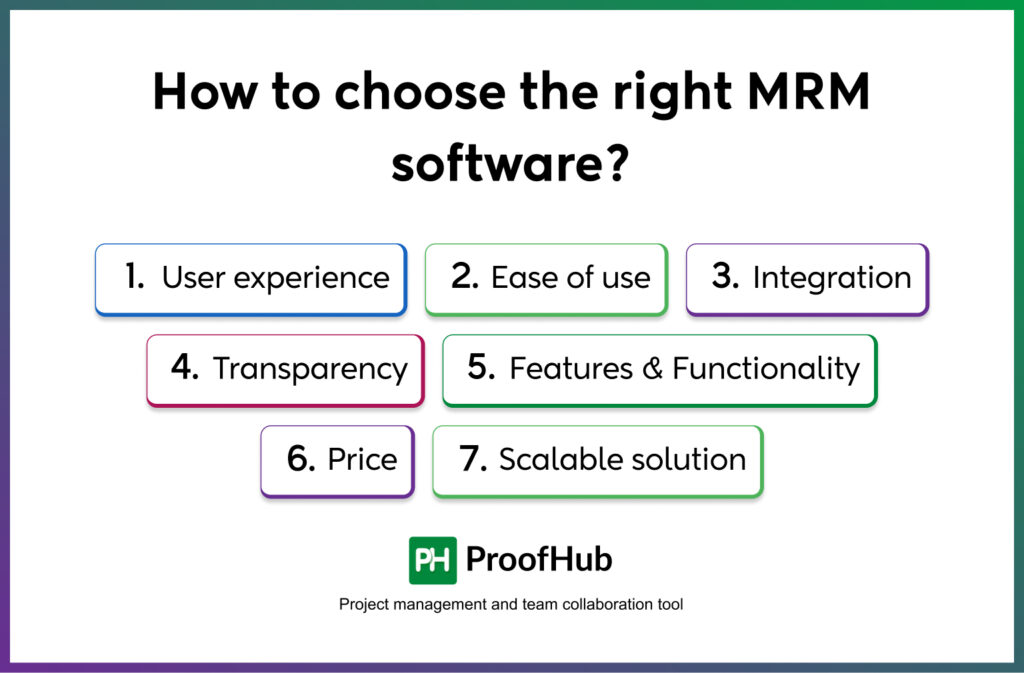
- User experience: You must explore software review websites like G2, Capterra, etc. to look for real user experiences and feedback.
- Ease of use: A tool that you choose must not throw a learning curve to add to your workload. It should be easy to grasp and intuitive.
- Integration: A good MRM should allow you to extend the tool’s functionality by offering integrations Or better look for a comprehensive solution.
- Transparency: A right MRM enhances transparency and visibility across all your marketing resources. It bridges the gaps and brings everyone on the same page.
- Features & Functionality: Look for a solution that equips almost all the necessary features to keep your marketing initiatives running smoothly.
- Price: Tool pricing is a major consideration. Look for solutions that provide value for the money.
- Scalable solution: Make sure the solution you pick doesn’t add to your budget with every onboarding. It should instead partner with your growth.
How to implement MRM software?
The Bayer Group is a great example of this implementation, which unified multiple and distinct brand entities into one cohesive space for significant savings and brand success.
Here is a roadmap to implementing an MRM software solution successfully in your company:
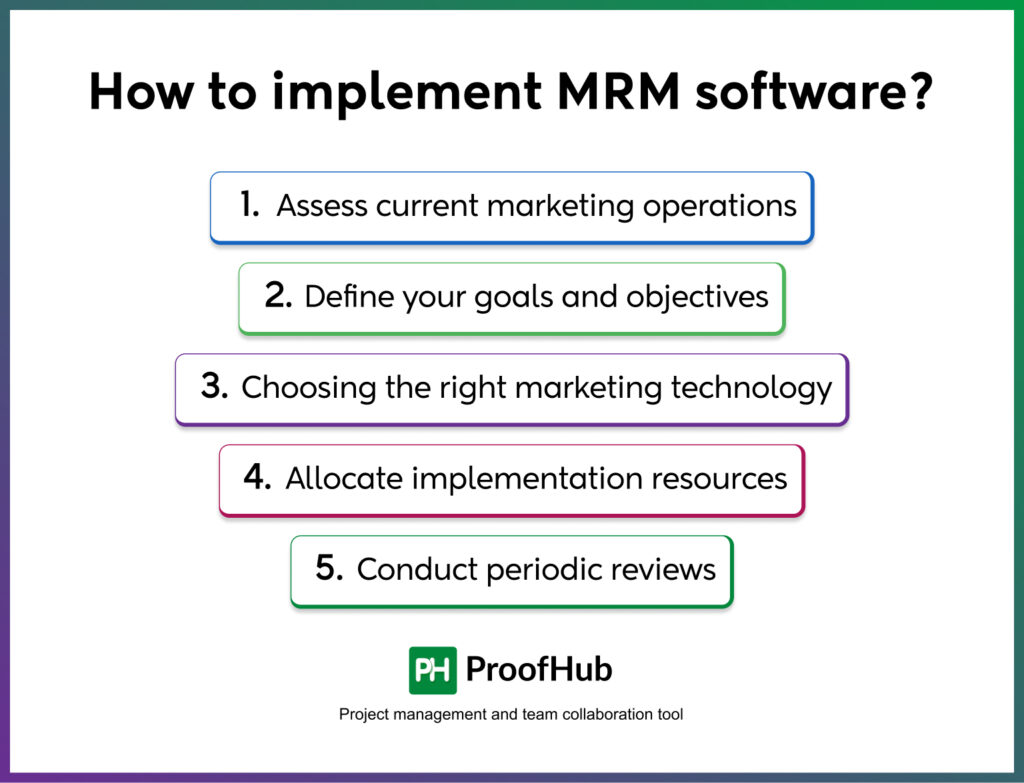
1. Assess current marketing operations
The first step towards implementing an MRM software is evaluating your current marketing processes. This will help you highlight the gaps and issues in your workflow, highlighting the areas for improvement. Also, knowing the functionalities team members expect from the solution is crucial.
2. Define your goals and objectives
After establishing roadblocks, it is time to define what goals you aim to achieve through MRM implementation. Is it the communication that you want to strengthen? Or, you want to enhance visibility across your operations. Or do you want to improve project management practices, or something else?
3. Choosing the right marketing technology
With multiple software options available in the market, choose the one with the feature set to help you achieve your goals. While considering options, do not surrender to unreasonable software pricing. If you end up feeling confused with multiple options, look out for the tool that takes an edge over others.
Enhance the capabilities of your marketing initiatives using ProofHub’s flat-fee pricing model without breaking your bank
4. Allocate implementation resources
Next, allocate specific financial and human resources for implementation. It is crucial to determine the total cost of implementing an MRM solution, to better forecast an idea of ROI and evaluate resources for team training.
5. Conduct periodic reviews
Lastly, do not settle down after implementation. Establish the frequency for MRM software review, who will oversee the operation, and how to maintain its effectiveness over time.
Manage your marketing resources with ProofHub
Marketing resource management is a powerful concept to empower marketing teams. It helps you execute campaigns faster by organizing assets and saving you the time that goes into looking for them.
A tool like ProofHub is a great tool for creative heads due to its immense digital marketing management capabilities. It provides the best of both MRM tools and project management software for streamlined marketing project execution.
From defining your marketing goals to eliminating blind spots and redundancies, ProofHub provides an integrated environment to help you operate at maximum potential.
FAQs
How does marketing resource management differ from traditional marketing strategies?
MRM and traditional marketing strategies are two entirely distinct approaches to marketing. Where traditional marketing strategies target creative and strategic aspects of marketing campaigns, MRM focuses on managing the resources required to execute those strategies.
What role does data analytics play in marketing resource management?
Data analytics plays an important role in MRM implementation. It allows managers to track historical data, identify gaps, and measure campaign performance.
What are the types of resources in marketing?
There are five major types of marketing resources –
- Budget
- People
- Supplies
- Technology
- Digital assets
What is the difference between CRM and MRM?
CRM and MRM are entirely different from each other in many ways.
- CRM focuses on managing customer relationships throughout the sales funnel, and MRM prioritizes managing marketing resources, like budget, people, marketing assets, etc.
- Some core functionalities of CRM include customer segmentation, lead nurturing, and customer service. On the other hand, managing marketing assets, tracking campaign performance, and optimizing resource allocation are some MRM traits.
Also read –

